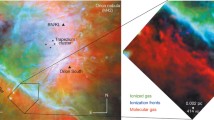Abstract
We have performed a theoretical calculation of the influence of radiative pumping on the populations of the rotational levels of the ground vibrational state for HD molecules under conditions of the cold phase of the interstellar medium. Two main excitation mechanisms have been taken into account in our analysis: (i) collisions with atoms and molecules of the interstellar medium and (ii) radiative pumping by the ultraviolet interstellar background. The radiative pumping rate coefficients \(\Gamma_{ij}\) corresponding to the average galactic ultraviolet background in Draine’s model have been determined. The influence of HD self-shielding on the radiative pumping rate coefficients has been studied. The population of the first HD rotational level (\(J=1\)) is shown to be determined mainly by radiative pumping rather than by collisions if the thermal gas pressure \(p_{\rm th}\leq 10^{4}\left(\frac{I_{\textrm{UV}}}{1}\right)\textrm{ K cm}^{-3}\) and the column density \(\log N({\textrm{HD}})<15\). In such clouds the relative population of the HD levels \(N(J=1)/N(J=0)\) turns out to be more sensitive to the ultraviolet background intensity than the relative population of the C I fine-structure levels. Thus, an analysis of the relative HD level population can become an important additional source of information about the physical conditions in the interstellar medium both in our Galaxy and in the forming galaxies of the early Universe.




Similar content being viewed by others
Notes
The abundance of CO is approximately the same as that of HD.
The rate of the induced transitions is much lower than the rate of the spontaneous ones and they may be neglected.
The population of the second C I\({}^{**}\) level shows approximately the same sensitivity as C I\({}^{*}\).
REFERENCES
H. Abgrall and E. Roueff, Astron. Astrophys. 445, 361 (2006).
H. Abgrall, E. Roueff, and Y. Viala, Astron. Astrophys. Suppl. Ser. 50, 505 (1982).
M. M. Asplund, N. Grevesse, A. J. Sauval, and P. Scott, Ann. Rev. Astron. Astrophys. 47, 481 (2009).
S. A. Balashev, A. V. Ivanchik, and D. A. Varshalovich, Astron. Lett. 36, 761 (2010).
S. A. Balashev and D. N. Kosenko, Mon. Not. R. Astron. Soc. 492, L45 (2020).
S. A. Balashev, P. Noterdaeme, H. Rahmani, V. V. Klimenko, C. Ledoux, P. Petitjean, R. Srianand, A. V. Ivanchik, et al., Mon. Not. R. Astron. Soc. 470, 2809 (2017).
S. A. Balashev, V. V. Klimenko, P. Noterdaeme, J.-K. Krogager, D. A. Varshalovich, A. V. Ivanchik, P. Petitjean, R. Srianand, et al., Mon. Not. R. Astron. Soc. 490, 2668 (2019).
J. H. Black and A. Dolgarno, Astrophys. J. 203, 132 (1976).
A. S. Dickinson and D. Richards, J. Phys. B: At. Mol. Phys. 8, 2846 (1975).
B. T. Draine, Astrophys. J. Suppl. Ser. 36, 595 (1978).
B. T. Draine and F. Bertoldi, Astrophys. J. 468, 269 (1996).
D. R. Flower, J. Le Bourlot, G. Pineau des Forets, and E. Roueff, Mon. Not. R. Astron. Soc. 314, 753 (2000).
A. V. Ivanchik, S. A. Balashev, D. A. Varshalovich, and V. V. Klimenko, Astron. Rep. 59, 100 (2015).
E. B. Jenkins and T. M. Tripp, Astrophys. J. 734, 32 (2011).
V. Klimenko, S. A. Balashev, A. V. Ivanchik, and D. A. Varshalovich, Astron. Lett. 42, 137 (2016).
D. N. Kosenko and S. A. Balashev, J. Phys.: Conf. Ser. 1135, 012009 (2018). doi 10.1088/1742-6596/1135/1/012009
S. Lacour, M. K. Andre, P. Sonnentrucker, F. Le Petit, D. E. Welty, J.-M. Desert, R. Ferlet, E. Roueff, et al., Astron. Astrophys. 430, 967 (2005).
H. S. Liszt, Astrophys. J. 799, 11 (2015).
P. Noterdaeme, C. Ledoux, P. Petitjean, F. Le Petit, R. Srianand, and A. Smette, Astron. Astrophys. 474, 393 (2007).
P. Noterdaeme, R. Srianand, H. Rahmani, P. Petitjean, I. Paris, C. Ledoux, N. Gupta, and S. Lopez, Astron. Astrophys. 577, 24 (2015).
E. Oliva, A. Tozzi, D. Ferruzzi, M. Riva, M. Genoni, A. Marconi, R. Maiolino, and L. Origlia, Proc. SPIE 10702, 18 (2018).
F. le Petit, E. Roueff, and J. le Bourlot, Astron. Astrophys. 390, 369 (2002).
B. Shustov, A. I. Gomez de Castro, M. Sachkov, J. C. Vallejo, P. Marcos-Arenal, E. Kanev, I. Savanov, A. Shugarov, et al., Astrophys. Space Sci. 363, 62 (2018).
A. I. Silva and S. M. Viegas, Mon. Not. R. Astron. Soc. 329, 135 (2002).
T. P. Snow, T. L. Ross, J. D. Destree, M. M. Drosback, A. G. Jensen, B. L. Rachford, P. Sonnentrucker, and R. Ferlet, Astrophys. J. 688, 1124 (2008).
L. Spitzer, J. F. Drake, E. B. Jenkins, D. C. Morton, J. B. Rogerson, and D. G. York, Astrophys. J. 181, L116 (1973).
L. Spitzer, W. D. Cochran, and A. Hirshfeld, Astrophys. J. Suppl. Ser. 28, 373 (1974).
A. Sternberg and A. Dalgarno, Astrophys. J. Suppl. Ser. 99, 565 (1995).
D. A. Varshalovich, A. V. Ivanchik, P. Petitjean, R. Srianand, and C. Ledoux, Astron. Lett. 27, 683 (2001).
D. E. Welty, J. T. Lauroesch, T. Wong, and D. G. York, Astrophys. J. 821, 118 (2016).
J. Wolcottgreen and Z. Haiman, Mon. Not. R. Astron. Soc. 412, 2603 (2011).
A. M. Wolfe, E. Gawiser, and J. X. Prochaska, Astrophys. J. 593, 215 (2003).
ACKNOWLEDGMENTS
This work was supported by the Russian Science Foundation (project no. 18-12-00301).
Author information
Authors and Affiliations
Corresponding author
Additional information
Translated by V. Astakhov
Rights and permissions
About this article
Cite this article
Klimenko, V.V., Ivanchik, A.V. Influence of Radiative Pumping on the HD Rotational Level Populations in Diffuse Molecular Clouds of the Interstellar Medium. Astron. Lett. 46, 224–234 (2020). https://doi.org/10.1134/S1063773720040064
Received:
Revised:
Accepted:
Published:
Issue Date:
DOI: https://doi.org/10.1134/S1063773720040064



